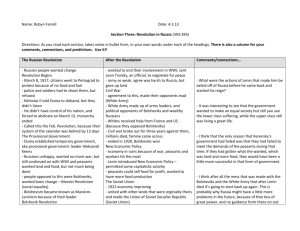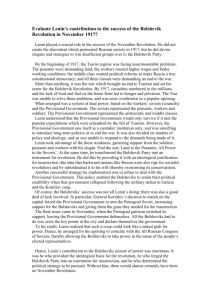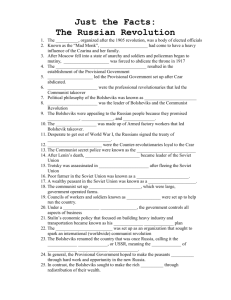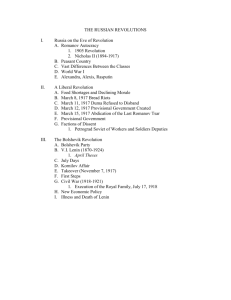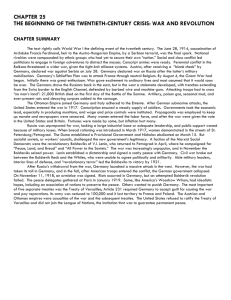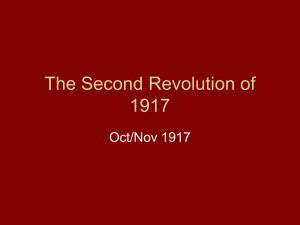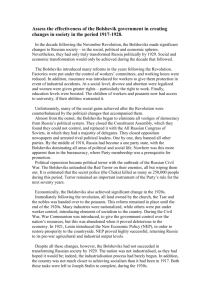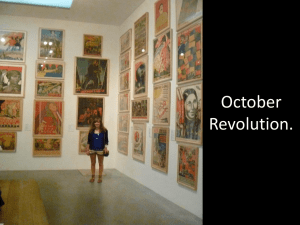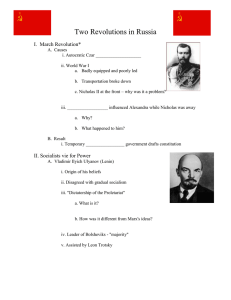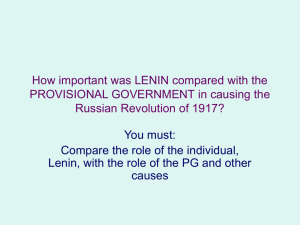Notes on Russian Revolution 1917-1924
advertisement
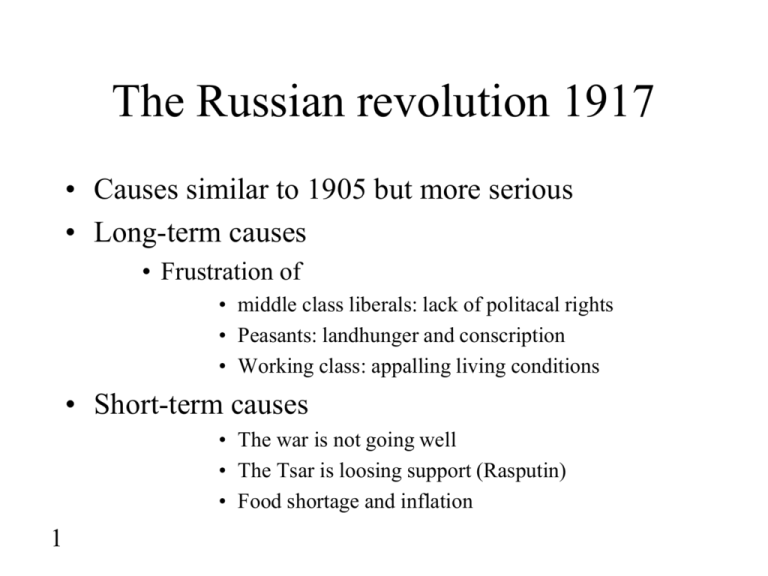
The Russian revolution 1917 • Causes similar to 1905 but more serious • Long-term causes • Frustration of • middle class liberals: lack of politacal rights • Peasants: landhunger and conscription • Working class: appalling living conditions • Short-term causes • The war is not going well • The Tsar is loosing support (Rasputin) • Food shortage and inflation 1 February revolution • Strikes and mutinies in St. Petersburg lead to the abdication of Tsar Nicholas II • The Power vacuum was filled by the Provisional government and the Petrograd soviet. • Soviet: Council “ráð” • Petrograd: St. Petersburg (later Leningrad) 2 Bolsheviks take power 25. october 1917 3 Another forgery 4 The “dual” government • Provisional government • first controlled by liberal parties (cadets and octobrists) but later by Social revolutionaries and Menshevicks under the leadership of Kerensky. • Saw itself as a caretaker government and did not propose any dramatic changes • Showed strength during the july days but discredited after the Kornilov affair 5 • Petrograd soviet • assembly of workers and soldiers under influence of SR and Menshevicks in the beginning but later Bolsheviks take control. • Lenins April thesis gathers support to the Bolsheviks and Lenin sets the course on a second revolution. • The Kornilov affair convinces Lenin that Bolsheviks should try to seize power The October revolution • Lenin gave the signal but Trotski controlled the operation • Was it a popular uprising or a coup d´etat? • Did a small group of extremist and organized political adventurers grasp power in the vacuum created by the weakness of the provisional government 6 Elections Nov. 1917 mill. votes SR 21.8 Bolshev. 10.0 Cadets 2.1 Menshev. 1.4 others 6.3 total 41.6 7 seats 438 168 17 18 62 703 % 53 24 5 3 15 First actions of the government • • • • • The Decree of Workers Control (Nov 1917) The Land Decree (Nov 1917) Constituent assembly disbanded in january 1918 Bolsheviks gain control of soviets across the country The treaty of Brest-Litovsk 3 march 1918 • Peace agreement with Germany resulting in heavy losses of land, people and resources • How did these call for a civil war? • What was the reaction of the allies? 8 Rollsinn hans Leníns 9 Questions • Was revolution inevitable, even without the war • What is the strength of the bolsheviks, compared to mensjeviks and Social revolutionaries • What difference did Lenins arrival on the scene en have? 10 War communism 1918-20 • Attack from whites and foreign nations brought about “emergency” measures: – Trotsky founded the red army – Cheka directed the red terror agains political opponents – War communism: • State control of industry • One-man management of factories • grain extracted from peasants • rationing of food 11 Why did the bolsheviks win the Civil war • “objective factors:” • Bolsheviks held the most populated area (more manpower • armaments industry was in their area • Bolsheviks controlled the core of the railway network • The Whites didnt get support because they wanted to take the land back from the peasants and did not listen to separatists. 12 New Economic Policy 1921 • Unrest spreads after the end of the civil war • peasants - workers - Kronstadt soldiers • Lenin has to respond: – NEP created a mixed economy • grain tax, private small businesses, free market for food and consumer goods, state control of heavy industry, railways and export. • to silence critics the rule and discipline of the party was tightened. 13 The proletarian state survived • We have a state that has experienced a social and political revolution and survived a civil war. • What kind of state is this? • What are the prospects of this state? 14


